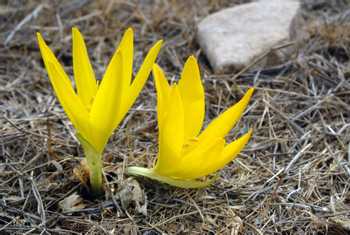Seeing the wonderful scenery, learning about the varied wildlife especially the botany. The wonderful picnic lunches provided each day by the leaders which included a fantastic choice of local foods. The atmosphere amongst a very pleasant group of people.
J.O, Kent, Oct '22



Tour Itinerary and Reports
- Itinerary
- Tour report - October 2022
- Tour report - October 2020
- Tour report - October 2019
- Tour report - October 2018
- Tour report - October 2017
- Tour report - October 2015
- Tour report - October 2014
- Tour report - October 2013
- Tour report - October 2012
- Tour report - October 2011
- Tour report - October 2010
- Tour report - October 2009
- Tour report - October 2009
Click to see moreClick to see less
Can I help you?
Autumn Plants of the Peloponnese
Tour Code: GRC07An 8-day holiday to the Peloponnese in search of the wonderful displays of autumn-flowering bulbs among the limestone mountains and plains of ancient Sparta.
£1,995
£1,795
Highlights
Tour Itinerary and Reports
- Itinerary
- Tour report - October 2022
- Tour report - October 2019
- Tour report - October 2020
- Tour report - October 2018
- Tour report - October 2015
- Tour report - October 2017
- Tour report - October 2013
- Tour report - October 2014
- Tour report - October 2012
- Tour report - October 2011
- Tour report - October 2010
- Tour report - October 2009
- Tour report - October 2009
Click to see moreClick to see less
Can I help you?
Quick Enquiry
Summary
As the heat of summer gives way to the cooler temperatures and rains of autumn, many plant species, including a variety of crocuses burst into flower on the Peloponnese peninsula in southern Greece. During this 8-day botanical holiday we explore the limestone mountains and valleys of this dramatically beautiful landscape in search of the exceptionally varied autumn flora. Whilst our attention will inevitably be directed towards the plants, we will also have time to enjoy the general natural history of the Peloponnese and admire the numerous well-preserved remains of Classical antiquity and the Byzantine monuments which are a feature of the region.
- Tremendous scenery
- Well-preserved ancient monuments
- Unspoilt Greek villages & fishing ports
- Autumn flowering crocuses & other plants
- Guided by Naturetrek botanist, David Tattersfield
Grading
Grade A. Easy day walks only.
South of mainland Greece, and joined to the rest of the country only by the 6-kilometre Corinth isthmus, lies the Peloponnese. This enormous peninsula is strewn with the remains of classical antiquity and Byzantine monuments, and it also contains some of Greece’s most spectacularly varied scenery — high mountains, attractive streams, fertile plains, valleys and lovely beaches. The area is richly endowed, both in names famous from Greek mythology, and nature. As well as being pleasing to the eye, the area’s karst scenery creates rich limestone soils on which grow the Peloponnese’s famous assemblage of autumn-flowering bulbs.
The Peloponnese endures relentless heat from June to September, but the earth here comes to life once again in the autumn and early winter. The local plant-life has evolved to escape the intense summer heat by growing during the early and latter months of the year, and many species choose to flower at this time. The region is, therefore, justly famous for its diversity of autumnflowering bulbs, and these will be the focus, and highlight, of our tour — indeed, it is the only place in Europe where it is possible to see cyclamen, crocus and snowdrops in flower at the same time!
Forested mountains and idyllic beaches characterise the Peloponnese landscape. On a map, the peninsula’s shape is reminiscent of fingers spreading out into the sea, each ‘finger’ with its own characteristic micro-habitats and flora, while the severe Taygetos mountain range rises steeply to the west of the Plain of Sparta. The limestone peak of Mount Taygetos stands 2,404 metres high and is clad in forests of Black Pine and fir. Following one night in Mykines, we move to the charming seafront town of Gytheio for the remaining five nights of the tour. Gytheio is the gateway to the Mani Peninsula, and is an ideal base from which to explore the region’s three areas of key botanical interest, Mani, Mystras and Malea, which jut out into the Aegean Sea. Even in late autumn the weather in this part of Greece is typically still warm and sunny, providing ample opportunities to enjoy full days of botanising, to venture in search of specific floral treats, to eat al fresco and to soak up the last rays of European sun for the year.
Though familiar in Britain as one of the harbingers of spring, approximately one third of all crocus species (there are 80 in total) flower in autumn and some right through the winter. In the Peloponnese, as the summer temperatures cool down and the first rains arrive, the flowering of crocuses and other plants is triggered. Nestled among the moist stream beds and gorges of the Taygetos Mountains are patches of cyclamen and snowdrops, and of particular interest are the delightful blooms of Galanthus reginae olgae and widespread Cyclamen hederifolium spp. crassifolium. Some late-flowering stands of Colchicum spp. also appear at this time of year, as well as crocus, which flower in great profusion on these slopes!
To the east of Gytheio, Malea is home to the small, pale lilac Crocus hadriaticus ssp. parnonicus as well as breathtaking displays of Crocus goulimyi in season, and these stands are often accompanied by Crocus laevigatus. The white blooms of the latter are a treat to see, for they are unique to the Peloponnese, its petals being striped in Crete! Among the many special crocuses of this area is the endemic Crocus biflorus ssp. melantherus which blooms in autumn — in fact, it is the only one of the four biflorus subspecies to flower at this time of year, and represents a unique adaptation to survival here in the country’s driest region.
The central of the three peninsulas we will explore on this tour is Mani, and it is here we will hope to find the largest of the crocuses, Crocus niveus. Its name means ‘of the snows’ — a somewhat curious choice for a plant which occurs down to sea level! It is a delightful member of the family, however, sporting large white and pale lilac flowers (which can be up to six inches high!) with deep yellow throats. In addition, the scented Cyclamen hederifolium ssp. confusum will be in flower, along with masses of Cyclamen graecum. Both are common on rocky hillsides and in olive groves at this time of year. Yellow Sternbergia are common throughout the Peloponnese and the curious aroid Biarum tenuifolium is another speciality here.
The Peloponnese is a rocky, starkly beautiful land baked by summer sun, and adorned in autumn with wonderful annual displays of autumn-flowering bulbs — and it is these little-known treasures of the region which will be the focus of this holiday, led by our expert and enthusiast, David Tattersfield.
Outline Itinerary

What's Included?
- Flights
- Accommodation:
We stay in comfortable hotels in Mykines and Gytheio, where all rooms have private facilities.
- Food:
All food is included in the price, with the exception of dinners in Gytheio. We recommend allowing around £100 for these.
Reviews
-
-
A week long botany holiday to see the spectacular autumn flowers (crocuses, cyclamen etc.) and other plants in the Greek Peloponnese, taking in the mountains and coast. There was also the opportunity to see some of the archaeological sites and sample some Greek hospitality. [Naturetrek] was really helpful and efficient, and the tour guide's botanical and geographical knowledge of the holiday location was second to none.
K.N. Kent, Oct 20 -
David found all that we were looking for. I would have liked to have spent more time at Mystras exploring the church frescos, but he got the balance more or less right. David is full of enthusiasm; Liz has a more caring aspect. They make the perfect team.
C.C. Somerset -
David Tattersfield has extensive knowledge of the area and the localised areas in which particular species are to be found. Barry Oxley was a wonderful addition, very cooperative. Great botanists, like David, don't grow on trees! I thought the itinerary was well-balanced. I loved the chance to visit the historical sites of Monemvasia and Mystras.
R.L. Canada -
Three of the sites taken to were of exceptional quality floristically - a wow factor.
S.B. Lancashire -
Organised, pleasant and hard-working tour leaders. Their knowledge and patience was impressive.
P.D. London -
The whole thing was very enjoyable.
S.L. Shropshire -
An excellent mixture of botanising, birding, history, archaeology and late autumn sunshine.
P.L. Shropshire -
The rain which preceded our arrival ensured the plants we'd come to see were in bloom in huge quantities - positive drifts or 'hosts' or whatever word seems most suitable of Cyclamen and Crocus. Quite wonderful! Lovely to see sunrise/sunset over Gythio harbour from the balcony. Having two leaders who so obviously get on well together and have similar attitudes to things was a real bonus.
J.S. Cornwall
Dates & Prices
2025

Tour Leader: David Tattersfield
David graduated in Botany and went on to do research in upland ecology. During a career with the Nature Conservancy Council and as a horticulturist with the National Trust for Scotland, he gained an extensive knowledge of the world's mountain floras. He is an energetic, experienced field botanist and photographer, and his love of mountains and wilderness has taken him to five continents. Above all, he enjoys sharing his enthusiasm for the natural world with others and has led trips for Naturetrek to a variety of destinations in Europe, north and south Africa and central Asia. Between tours David is based in Kirkmichael in highland Perthshire, where he works as a horticultural and ecological consultant and lectures on his travels.
Prefer to Travel in a Private Group?
For any interested natural history club or society, we can arrange for a private departure of this tour.
Enquire
Tour Reports
- Tour report - October 2022
- Tour report - October 2020
- Tour report - October 2019
- Tour report - October 2018
- Tour report - October 2017
- Tour report - October 2015
- Tour report - October 2014
- Tour report - October 2013
- Tour report - October 2012
- Tour report - October 2011
- Tour report - October 2010
- Tour report - October 2009
- Tour report - October 2009
CLICK TO SEE MOREClick to see less
Why Naturetrek?
At Naturetrek we craft expertly-guided group and tailor-made wildlife holidays and cruises to all seven continents. On one of our holidays, you can be assured that our passionate team will enable you to experience and enjoy the best of the world's wildlife and natural spectacles in as comfortable and rewarding a manner as possible, caring as best we can for the environment in the process. We are proud to provide:
- The widest choice of wildlife holidays worldwide
- Tours managed and led by naturalists, for naturalists
- Outstanding value and exceptional customer service
Furthermore, as a Naturetrek client, our office team are always to on hand to help you – so if you have any queries about your holiday, whether before or after you have booked, we will be delighted to answer them on the phone. Please just give our team a call!
Related articles
Everybody knows that the flowering season is too short. Here are a few of our favourite autumn tours with a strong botanical element... to extend the season!



 Loading search...
Loading search...


























